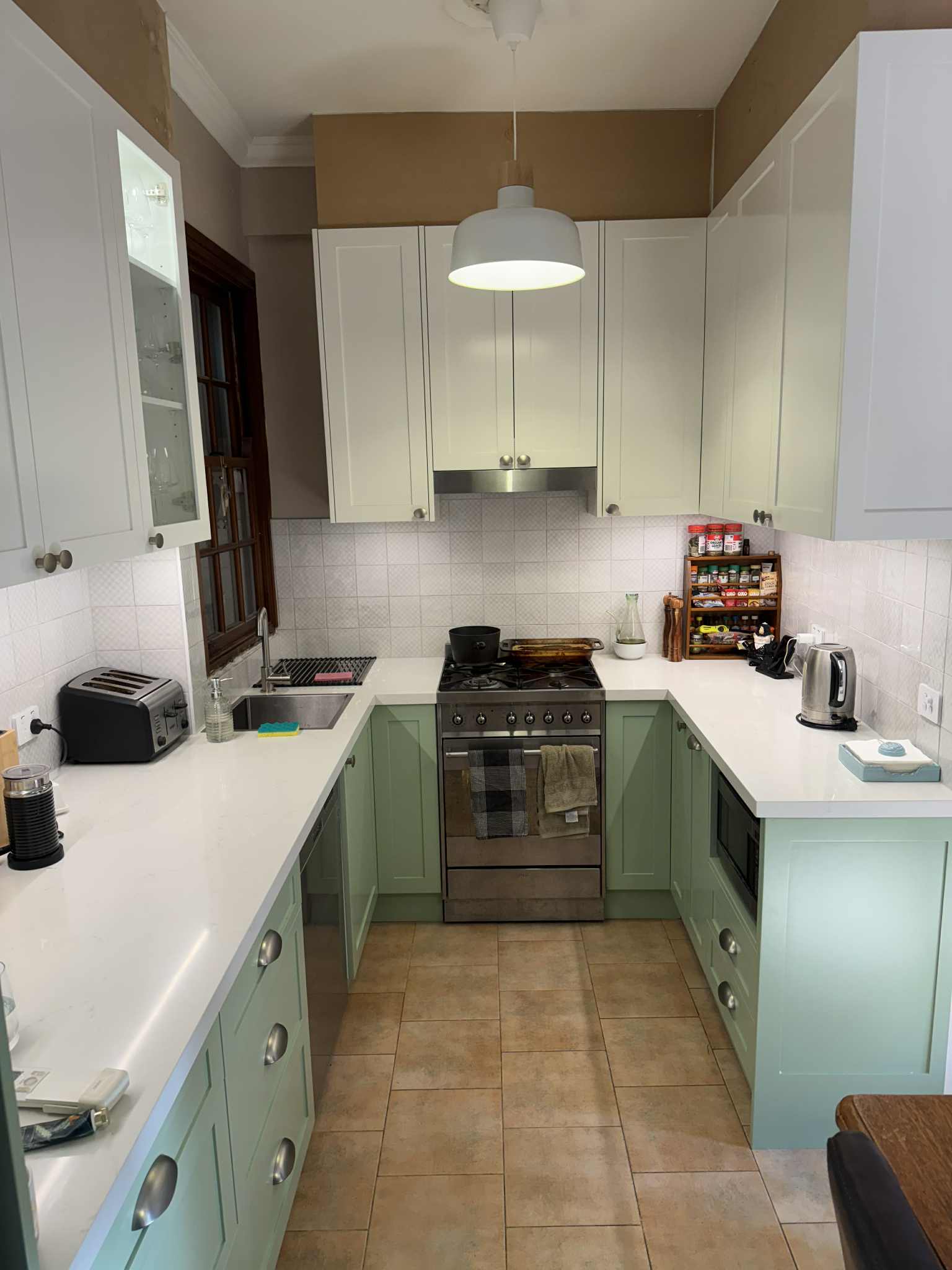Why Efficient Lighting Matters in Kitchens
- Lower energy bills: Modern LEDs can use up to 80% less energy than old halogens.
- Better visibility & safety: Good task lighting reduces shadows on benchtops and cooktops.
- Comfort & ambience: Proper colour temperature + dimming keeps mornings crisp and dinners relaxed.
- Longevity: Quality fittings & drivers = fewer failures and call‑outs.
Tip: For most Sydney homes, 3000–4000K LEDs deliver a clean, neutral white that suits cooking while still feeling inviting.
The Three-Layer Plan We Recommend
A reliable kitchen lighting layout uses three layers. In this project, each supports visibility around cooktop, sink and benches.
1) Ambient Lighting (Base Layer)
Fills the whole space so you’re not working in pockets of shadow. Often a grid of efficient LED downlights or a central high‑output feature fitting.
What to look for:
- High‑efficiency LED (high lumens, low wattage)
- Uniform distribution to avoid dark corners
- CRI ≥ 90 for natural colour rendering
2) Task Lighting (Work Zones)
Targets prep, cooktop and sink areas. Depending on cabinetry we often recommend:
- Under‑cabinet LED strip lighting for shadow‑free benches
- Rangehood lighting focused on the cooktop
- Downlights aligned with the bench edge (not behind the user)
PrimeTime tip: Mount under‑cabinet strips toward the front to wash the surface evenly and hide LED dots. Use quality extrusion + diffuser for a continuous bar of light.
3) Accent & Feature Lighting
- Statement pendant over island or central zone
- Kickboard strip for a floating effect
- Glass‑cabinet or shelf lighting for display areas
Small wattage; big visual impact.
Controls that Save Power (and Feel Premium)
- Dimmers for mood vs prep intensity
- Two-/three‑way switching in U‑shaped layouts
- Motion / door sensors for pantries
- Smart timers & schedules to limit overnight usage
Pairing efficient LEDs with dimming is an easy comfort + efficiency win.
Our Installation Checklist
- Load calculations & circuit planning
- Placement to minimise glare + bench shadows
- Driver placement with service access
- Neat cable management & terminations
- Clear handover: controls, dimmer compatibility, care
Choosing Colour Temperature & CRI
- ≈3000K warm white: Cosy in open‑plan living.
- ≈3500–4000K neutral: Crisp for food prep, keeps colours true.
- CRI ≥ 90: Accurate splashback, timber & food tones.
Green or stone cabinetry? Neutral white often avoids colour cast while staying inviting.
Cost-Smart Upgrade Steps
- Swap halogen downlights for high‑efficiency LED modules
- Add under‑cabinet strip with slim switch or sensor
- Install an efficient feature pendant (quality lamp/driver)
- Add dimmers to main circuits for instant comfort + savings
These four moves deliver big gains in brightness, efficiency and aesthetics.
Service Areas (Sydney)
St George: Oatley, Hurstville, Mortdale, Beverly Hills, Riverwood, Penshurst, Lugarno.
Inner West: Newtown, Enmore, Erskineville, Marrickville, Dulwich Hill, Petersham, Stanmore, Summer Hill, Ashfield, Haberfield, Croydon, Leichhardt, Lilyfield, Annandale, Balmain, Rozelle, Drummoyne, Five Dock.
Northern Sydney: Lane Cove, North Sydney, Neutral Bay, Mosman, Cremorne, Chatswood, Willoughby, Artarmon, St Leonards, Crows Nest, Ryde, Hunters Hill.
FAQs: Kitchen Lighting Upgrades (Sydney)
Can you retrofit existing fittings?
Yes—most older halogens can be upgraded to efficient LED with better output and less heat.
Will LED strips look harsh?
Not with proper diffusers, correct placement and a suitable colour temperature.
Do I need a licensed electrician?
Yes. Safe wiring, compliant drivers, correct circuit loading and certified connections protect your home and insurance.
Get a Kitchen Lighting Assessment
Request a Kitchen Lighting Quote
General information only. Always seek a site assessment by a licensed electrician. Product names are trademarks of their respective owners.
